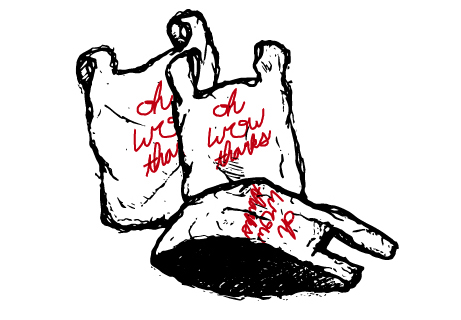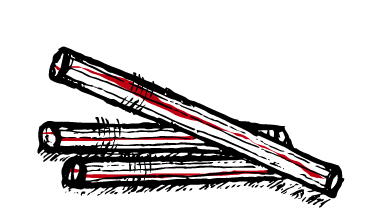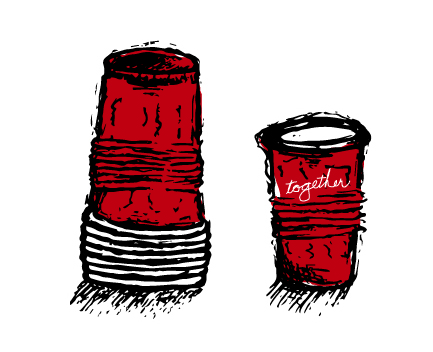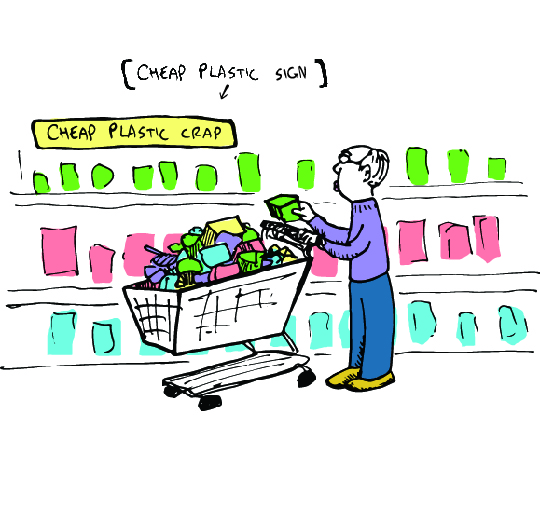Before plastic polluted our oceans and landscapes, the use of modern plastic began with Bakelite, first invented by the Belgian American chemist Leo Baekeland in 1907. At its time, the invention was considered revolutionary because it could be used in electrically powered machinery. Today the word “plastic” belongs to a large family of synthetic or semi-synthetic organic compounds that can be shaped and molded into physical objects.

The popularization of synthetic organic compounds started some years before Bakelite, with the 1862 invention of Parkesine by Alexander Parkes. Parkesine was first made public at the Great International Exhibition in London. Parkes made this material from the cellulose found in the cell walls of plants. Initially promoted as an inexpensive replacement for rubber, Parkesine was moldable, transparent, and maintained its shape after cooling. From Parkesine to PVC and Polyester, the family of plastics were introduced as an alternative to other expensive resources at the time. The intentions for plastic were both commercial and practical. Born and tailored for good intentions, the material now poses a threat to the planet due to its trademark feature: it does not decompose.
Once an extremely popular friend, plastic is now one of the most dangerous pollutants out there. Its durability and cheap production costs have caused plastics to be present everywhere. According to Surfers Against Sewage (SAS), 8 million pieces of plastic are entering the oceans every single day. When discussing plastic pollution, it almost always concludes with the ocean being the last and biggest victim. This is because most of the plastic comes from land as litter and ultimately gets washed down rivers and streams then out into the ocean. To put a number on how much plastic the ocean harbours is shocking. SAS estimates that our oceans contain “approximately 51 trillion microscopic pieces of plastic, weighing 269,000 tons.” And since plastic decomposes at such a slow rate, it often gets consumed by marine creatures—and if we follow the food chain, our supper might end up containing a bit of synthetic plastic garnish. It’s in our oceans, and in our food chain, and in our bodies, without us even realizing it. Scientists just don’t know what effects it will have on our long term health.
Despite the dangers plastics pose to the environment, there seems to be a buffer zone for humanity. It’s as if we care only until we feel like it, or in some cases we simply do not. A major factor that allows for this perspective is scale. For instance, one might think that no harm is going to come from throwing a plastic straw down a river; it would seem like adding a drop of water to the sea. But the scenario would look deadly when there are a million other people who think the same way. That is how the problem of plastic magnifies. Because of how little damage people think they are doing, the true gravity of the problem becomes much more terrifying. Through selfishly choosing to not care about smaller amounts of plastic pollution at an individual level, we allow the problem to amplify on the much bigger national and global scale.

The act of not caring tends to be a result of two different processes of thought. On a global perspective, western countries have this problem of plastic ending up in the wrong places, but there are also steps being taken against that. People are aware, to an extent, that a plastic problem exists and that measures and initiatives that are being conducted are proving fruitful. For example, how some restaurants have stopped giving out plastic straws, unless one is asked for, or only offer plastic straw alternatives. The pollution still exists but it is controlled, managed, and supervised.
On the other side of the planet, the relationship with plastic is rather different. Industrialized countries in the East, like Japan, Australia, and Singapore also deal with plastics in their environment. With many modernized countries, there exists this balance of pollution and cleaning up, acknowledging that there is a real threat. However, a bigger picture of the plastic problem can be seen in countries in the Indian subcontinent. The degree to which people have abused their relationship with Mother Earth is frightening. I am a citizen of Bangladesh and I have visited a few Asian countries nearby. I have witnessed for myself this unhealthy attitude people have with plastics. Countries like Bangladesh did not always have a plastic problem. But over time, our low labor costs attracted foreign manufacturers, and industrialization took over rapidly. This, however, does not mean we weren’t using plastic before, but now we mass produce it. Before that, Bangladesh used to use jute and fabric as a substitute for plastic.

Unlike western countries, waste management is a big problem in cities like Dhaka (capital of Bangladesh), Mumbai, Delhi and many more. There are fewer awareness movements and the consequences of abusing nature with plastic are never highlighted. Therefore, dumping plastic anywhere has become a crime without a punishment. It is not that people cannot understand what the damage will be. The problem is that people simply do not care. If there was a way to trace and punish people for polluting in countries like these, I believe cleaning up the Earth would be a much quicker process. Thankfully we are seeing measures being taken and the situations addressed in these countries. A great example is the Sonali Bag, a jute fibre bag that does not harm the environment. Developed by the Bangladeshi scientist, Dr Mubarak Ahmad Khan, he named the discovery that took six years as “jute polymer.” According to an article in The Daily Star, its unique future is that it is water resistant, decomposes within three to four months under soil, and support weights one and a half times more than what polythene can bear. Apart from scientific breakthroughs like this, countries like Bangladesh receive generous donations and aids to tackle problems in pollution.
While some scientists are discovering cheap biodegradable bags, others are finding bacterial species that eat plastic. According to an article by the The Guardian, a team of Japanese researchers described a species of bacteria that can break the molecular bonds of one of the world’s most-used plastics, polyethylene terephthalate, also known as PET or polyester. The team in charge carefully studied lots of PET debris until the bacterial species was discovered. Dr. Tracy Mincer, a researcher from Woods Hole Oceanographic Institution, commented that “This is the first rigorous study—it appears to be very carefully done—that I have seen that shows plastic being hydrolyzed [broken down] by bacteria.”
I believe that since most of the plastic ever produced is still somewhere on the planet, we really don’t need any more. The very first step in tackling the plastic problem is addressing the consequences and reducing the production of plastic. In the time we live in, there are many other, better alternatives to plastic. Even if that means rising costs, I believe that would be a price we should all be happy to pay. Not doing anything and just watching the world suffocate in our plastic waste is, perhaps, a much higher price anyway.





